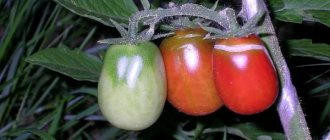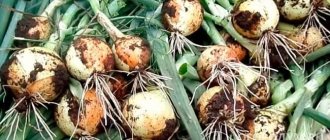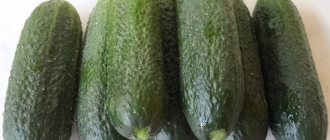Tomato variety Cardinal
Tomato Cardinal is a long-proven variety that enjoys well-deserved popularity. In the south it is grown in open ground, in the regions of the middle zone and in the north - in greenhouses. Tomatoes grow sweet, large and attractive in appearance.
Tomato variety Cardinal
general characteristics
The Cardinal tomato variety belongs to the group of indeterminate ones and often requires pinching. The bush reaches a height of 150 cm in open ground and 200 cm in a greenhouse. It is formed into 1 or 2 stems.
The variety is mid-early: the fruits begin to ripen in the second half of July. The harvest is harvested until the very end of the season.
Fruit
Tomatoes are distinguished by a slightly flattened heart-shaped shape with weak ribbing. They are raspberry or red in color, taste sweet, with a slight sourness.
The pulp is dense and fleshy, the skin is thin but durable and does not crack.
The initial harvest is ideal for salads and slices, and later smaller tomatoes can be canned. They are also used to make juices, sauces, and tomato snacks.
Productivity
From one bush you usually get 4-6 kg. Since the fruits are massive, this yield is considered average.
By forming a bush with 1 stem, you can grow larger fruits, but in smaller quantities. Forming 2-3 stems allows you to increase their number, but they will be smaller in size.
Advantages and disadvantages
According to the description, the advantages of Cardinal tomatoes include:
- excellent taste;
- large fruit;
- resistance to diseases.
There are no obvious shortcomings, but there is a need for additional care (forming a bush, tying up stems and brushes).
Sowing
Plants need to be hardened off before planting.
- When growing tomatoes in a greenhouse, seeds for seedlings should be sown in early March. Usually by May it is ready for transplantation.
- When grown in open ground, the dates are shifted to the end of March - beginning of April, and replanted in June.
The seeds are first soaked in a manganese solution (for 20 minutes) for disinfection. They are deepened into the soil by 1-1.5 cm, and then the crops are moistened with a spray bottle.
Seedlings are picked after the appearance of two true leaves. At the same time, plants are fed with mineral fertilizers.
10 days before transplanting, the tomatoes are hardened - they are taken outside every day. The time is gradually increased, starting with 30 minutes and ending with 8-10 hours.
Tatyana Orlova (Vasilidchenko) (candidate of agricultural sciences):
Seedlings are planted in a greenhouse or open ground at an air temperature of at least 17-18 degrees. The soil should be warmed above 10 degrees Celsius.
Transfer
Young plants are planted in loosened and fertilized soil, having previously installed a support or trellis for tying.
After planting, the tomatoes are watered with warm, settled water strictly at the root.
Mandatory care measures include watering. Plants are watered several times a week with settled warm water.
To control humidity levels, the greenhouse is regularly ventilated. The soil in the beds is carefully loosened and weeded, creating conditions for the growth and nutrition of roots. To facilitate maintenance and retain moisture, the soil is mulched.
Tatyana Orlova (Vasilidchenko) (candidate of agricultural sciences):
If there is excess moisture in the greenhouse, the ground becomes covered with a green coating. This plaque is microscopic green algae. In themselves, they are not dangerous for tomatoes, but are an indicator of constant high soil moisture, which can lead to root rot and other diseases.
Fertilizing is carried out twice a month (to increase productivity, this is done three times). At the growth stage, nitrogen must be present in the fertilizer complex.
Diseases and pests
According to their characteristics, Cardinal tomatoes are resistant to diseases and pests, but preventive measures are never superfluous.
To avoid diseases, it is necessary to adhere to the rules of crop rotation, disinfect the soil with a manganese solution, weed the beds on time and inspect the plants.
Aphids, whiteflies, slugs, and spider mites pose potential dangers to tomatoes.
Often, pests can be washed off the leaf with a soap solution or driven away with biological products, but if this does not help, insecticides are used for control (against ticks - acaricides).
Description of the Cardinal tomato variety: a classic large fruit for your garden
Cardinal is one of the best and time-tested tomato varieties, which has been grown by gardeners in various parts of Russia for more than 20 years. It will appeal to lovers of large-fruited tomatoes with fleshy pulp and a sweet taste. We’ll tell you what other features are characteristic of this variety and how to grow it correctly to get a rich harvest.
Description and characteristics of tomato Cardinal
Cardinal is a mid-season tomato variety, the first fruits of which ripen 110–115 days after the appearance of mass shoots. It was registered in the State Register in 1998. The tomato is intended primarily for cultivation in greenhouses, however, in regions with mild climates, its cultivation in open ground or greenhouses is allowed. There are no special recommendations for the growing region (provided the bushes are kept in a greenhouse).
Tomato Cardinal requires pinching and tying to trellises. Moreover, so many fruits can form on the bushes that sometimes you have to tie up the branches separately. Each cluster can simultaneously ripen up to 10 fruits weighing about 300–600 g. The first tomatoes are always larger: their weight can reach 700–800 g. The yield of the variety is about 4–5 kg per bush.
Tomatoes have a salad purpose. They do not tolerate transportation well and cannot be stored for a long time. Therefore, it is better to eat them fresh. But tomatoes can also be used to make paste, juice or sauces. Whole-fruit canning is impossible due to the large size of the fruit.
Cardinal tomato fruits are suitable not only for fresh consumption, but also for making tomato paste
Appearance of the bush and fruits
Cardinal forms a semi-determinate, compact but tall bush with a powerful root system. In a greenhouse its height reaches 1.8–2 m, in open ground - 1.5–1.6 m. The foliage is average, medium-sized, slightly corrugated leaves are colored light green. The fruit begins to set above the 8th or 9th leaf. Then brushes are formed every 1–2 sheets.
The fruits of the Cardinal tomato are heart-shaped, large in size and red in color with a raspberry tint.
The rounded fruits are heart-shaped and slightly ribbed on the sides. They are colored red-crimson. The skin covering them is thin and matte. The number of chambers and seeds inside is small. The pulp is juicy and sugary. Tomatoes have a classic taste and pleasant aroma.
Inside the Cardinal tomato fruit there is a fleshy and sugary pulp, and the size of the seed chambers is small
Advantages and disadvantages of the variety, features compared to similar ones
The main advantages of Cardinal tomatoes include:
- evenness of the fruits (they have approximately the same size and shape);
- large fruit;
- good yield;
- excellent taste;
- the fruits ripen well after being picked from the bush at the blanzhe stage of ripeness;
- the seeds are suitable for harvesting and sowing for seedlings next year.
The main disadvantages of the variety are:
- tallness (bushes need to be pinched and tied up);
- strong dependence of yield on maintenance conditions (in a greenhouse it is significantly higher);
- low shelf life of fruits (they cannot be stored fresh for a long time);
- poor transportability (during long-term transportation of the crop, the fruits crack from shaking and turn sour).
It is worth comparing this variety with other large-fruited tomatoes. The Cardinal tomato is inferior in yield to the Mazarin tomato, which produces up to 14 kg of marketable tomatoes from 1 m2 of beds. But in terms of this same indicator, it surpasses Ox's heart (up to 4 kg of marketable fruits per 1 m 2) and Ox's heart (up to 6.9 kg per 1 m 2). However, Cardinal forms larger fruits (average weight 442 g), while the average weight of Mazarin fruits is 150-190 g, Oxheart - 108-225 g, Oxheart - 150 g (up to 300 g).
Growing Cardinal tomatoes
The bushes are planted in a permanent place according to a 60x70 or even 70x70 cm pattern. They are formed into one stem and tied to supports. Clusters with fruits are tied separately as needed so that they do not break under their own weight.
Caring for tomatoes consists of regular watering, protection from pests, pinching and fertilizing. As necessary, the soil underneath is loosened and weeded. Tomatoes respond well to mulching the soil with straw or hay.
Characteristics and description of the Cardinal tomato variety, its yield and cultivation
Like any other tomato variety, Cardinal, adapted to Russian conditions, has pronounced unusual characteristics. It is distinguished from other varieties of salad varieties by the pink color of the fruit, its unusually large size and heart-shaped shape. The taste is excellent and has earned positive reviews from most gardeners.
Description of the variety "Cardinal"
Salad, large-fruited variety for growing in greenhouse conditions in central Russia. It is highly resistant to most diseases of nightshade crops.
A small characteristic and description of the tomato variety “Cardinal”:
- According to the growing season, the plant belongs to the mid-season category. From germination to fruiting, it requires a period of 110 to 120 days;
- The Cardinal variety belongs to the indeterminate category, with unlimited stem growth of 150 cm and above. Requires measures to form a bush and mandatory tying to a support;
- The plant is compact, weakly branched with medium-sized green mass. The leaves are of the ordinary type, slightly corrugated, medium in size, bright green;
- The formation of inflorescences occurs through 3 leaves, the first is laid over 8-12 true leaves. The fruits ripen in stages, on clusters of different levels;
- Cardinal tomato fruits are elongated-oval, heart-shaped with a sharp tip;
- the skin is thin, matte, pink with a raspberry tint;
- tomatoes are tasty, sweet, with sugary, juicy pulp, very good in fresh salads;
- The weight of the fruit approximately ranges from 300 to 800 g. The yield is average. Up to 4-7 kg of large-fruited tomatoes are collected from one bush.
The fruits have an attractive presentation, approximately the same in size and shape. Sufficiently long fruiting allows you to collect fresh tomatoes over a long period and significantly larger quantities per square meter.
Tall tomatoes have a well-developed main root and many adventitious roots growing from the stem
Water the plant carefully, trying not to expose additional roots that supply nutrients to the powerful plant.
Agricultural technology for growing the Cardinal variety
Agrotechnical methods for growing indeterminate varieties, which include the Cardinal tomato, are much simpler. A tall plant allows you to more rationally use the height of the greenhouse, receiving sufficient lighting and more actively participating in air exchange. Thanks to this, tomatoes are less likely to get sick. It is easier to form these types of tomatoes into one stem.
Growing seedlings of tall varieties and ordinary tomatoes is practically no different. If you plan to get the first tomatoes in mid-July, then plant the seeds for seedlings in mid-March. Plants dive with the appearance of the second true leaf.
Important! During the growing season, up to 12 ovaries have time to fully develop. This should be taken into account and the growing point should be pinched in time to obtain a harvest.
- Plants are transplanted to a permanent location in May at the age of 50-60 days. The recommended planting density is 5 plants per 2 square meters of area. Seedlings are planted in rows or in a checkerboard pattern every 55 cm, leaving row spacing 60 cm wide.
- The plant needs reliable support or gradual garter at several levels. You can use agricultural mesh, trellises or high stakes for support.
- The formation of tomatoes comes down to removing side shoots and dying foliage. Only the central trunk is left, which can, under favorable conditions, be thrown over the upper support and cut only at a distance of 50 cm from ground level.
- There are several formation methods. Opinions vary. In her reviews, a woman gardener shares her experience of how she grew the variety using two stems, leaving a side shoot under the first flower ovary. I have been planting tall tomatoes for several years now and this method is very convenient. In this case, when the main stem reaches the top of the greenhouse, it is pinched.
- If the plant is grown outside, then by August its growth is limited by pruning to allow the formed fruits to ripen. The timing is individual and depends on the climatic conditions of the region.
- Basic care techniques come down to regular watering and fertilizing. Water the plant at the rate of 1 bucket per bush about once a week. Water should not get on leaves and fruits.
- If the soil has been prepared since the fall and all necessary fertilizers have been applied before planting, then fertilizing is carried out approximately once a month. Taking into account the condition of the tomato bushes, one or another composition of fertilizing is selected.
Subspecies of the Cardinal variety
The Cardinal tomato has several varieties:
Cardinal Richelieu
Large, pink tomato. The shape of the fruit is round-flat. Valued for its high yield, 5-6 kg per bush. Suitable for making juices and fresh salads.
Cardinal Mazarin
Tall hybrid with high resistance to major diseases. The average yield, subject to agricultural technology, is up to 14 kg per plant. Forms clusters of 5-6 tomatoes. The fruits are heart-shaped with a characteristic pointed nose. The pulp is tender, juicy, sugary, the skin is dense.
Growing Cardinal tomatoes
Cardinal tomatoes: photo of variety
The Cardinal tomato variety shows the best results on light soil. It should be quite nutritious. You can prepare such soil yourself. To do this, you need to mix turf or garden soil and humus. The latter should be well rotted.
Do not neglect the rules of crop rotation. It is better to plant Cardinal tomatoes in areas where legumes, cucumbers, onions, carrots, and cabbage were previously grown. If the soil is not nutritious enough, you can additionally add wood ash and superphosphate.
As a rule, the time for sowing Cardinal tomato seeds for seedlings falls on the last days of March and the beginning of April.
First, it is necessary to disinfect the planting material; for this, a manganese solution is used. You need to keep Cardinal tomato seeds in it for about half an hour. After this time, the Cardinal tomato seeds should be rinsed with plain tap water. After this, leave them in the growth stimulator for eleven to twelve hours.
If you don’t want to buy a ready-made growth stimulator at a garden store, you can use fresh aloe juice, which must be diluted in warm water.
Then, when the seeds are ready for planting, they must be planted in a container filled with a nutrient substrate. The embedment depth is usually one and a half to two centimeters. Tomato seeds of the Cardinal variety can be immediately planted in peat pots. This way, when replanting, you will not damage the delicate root system of the plants. Planting them directly in such a container is safer than diving them.
After the Cardinal tomato seeds are sown, they need to be watered. It is best to use a spray bottle for this. Then cover the containers well with polyethylene and put them in a warm place. Now we just have to wait for the first tomato sprouts to appear.
How to properly transplant a Cardinal tomato into a greenhouse
Cardinal tomatoes: photo of variety
As for transplanting Cardinal tomatoes to a permanent habitat, it is done for different conditions at different times.
For example, Cardinal tomatoes are transplanted into an open area around the first week of June. And tomatoes are transferred to greenhouses and greenhouses two to three weeks earlier. Before planting the Cardinal tomato variety, add wood ash to each planting hole; one tablespoon per hole will be enough.
It is better to tie up Cardinal tomatoes immediately after you plant them. It is best to install a trellis for these purposes. You can attach stems to it, as well as branches with heavy tomatoes.
Remember that from time to time it is necessary to form tomato bushes. Periodically you need to remove the leaves located at the bottom of the plants. Side shoots are also usually removed. It is necessary to leave from one to two central shoots.
When the Cardinal tomato becomes tall enough, you need to pinch off the top. This way the plant will stop stretching upward.
As for watering, it should be moderate. To do this, the water must be settled and warm. It is necessary to apply nutritional supplements at least three times during the summer. You can use purchased complex fertilizers for this.
The Cardinal tomato variety shows excellent results both in open ground and in greenhouse conditions. There are no special care requirements; agricultural technology is similar to other tomato varieties.
The Cardinal tomato variety is well suited for both personal and commercial cultivation. Indeed, thanks to the structure of the fruit, such tomatoes can retain their presentation for a long time, even during transportation.
Cardinal tomatoes: video about the variety
Growing tomatoes
The advantages of growing Cardinal tomato are:
- high seed germination;
- fleshiness and large fruit;
- resistance to temperature changes. A cold summer will not cause a drop in yield;
- not susceptible to major tomato diseases, which will reduce the need for spraying with chemicals.
- good presentation of the fruit;
- storage duration;
- variety of uses.
When growing Cardinal tomatoes, the following disadvantages were identified:
- the need for pinching, as well as tying the stem and clusters with fruits to the trellis;
- the inability to pickle the whole fruit due to its large size.
The vegetable attracts gardeners and gardeners with the following advantages:
- The description of the variety begins with a mention of its versatility. Suitable for fresh consumption. All types of preparations cannot do without it when it is in the kitchen.
- Tomatoes are grown in open ground and in greenhouse conditions. When choosing a planting site, take into account the height of the bushes. If it is open ground, the height should not be lower than 1.5. In greenhouses - 2 m.
- The fruits of the variety are distinguished by their juiciness and unique tomato taste.
- In rare cases, it is susceptible to pest damage.
- After sowing the seed, shoots quickly appear. This indicates good quality planting material.
- The variety does not react in any way to bad weather conditions.
The disadvantages do not affect the cultivation of tomatoes. Rather, these are cultural features that a gardener should know about:
- It is recommended to tie the bush due to the length of the stem;
- to get high yields, it is necessary to form a bush in time;
- big size.
The review variety was bred by a group of Russian breeders. The copyright holder is , the originator is . Tomatoes were included in the Russian State Register in 1998. The main purpose of vegetables is cultivation in open ground and in greenhouses.
The main advantages of the Cardinal variety:
- Delicious fruits;
- Juicy and aromatic tomato pulp;
- Excellent presentation;
- High yield;
- Versatility in the use of fruits;
- Cold resistance;
- Excellent germination of planting material;
- Strong immunity to fungi and viruses.
The disadvantages of the review variety should also be noted:
- Bushes need to be formed;
- Tomato branches are strewn with heavy fruits, so they should be supported with pegs.
REFERENCE: Tomatoes can be planted in unprotected soil or under film cover, but in greenhouses the yield will be much higher.
The overview variety is grown by planting seedlings in open ground or a greenhouse.
Before planting, the seeds are soaked for 12 hours in growth stimulants. Freshly squeezed aloe juice can be used as a natural germination accelerator. For future seedlings, dense and whole seeds should be selected.
In mid-March, seed is planted in shallow containers. The soil should be light and nutritious. It is best to prepare a special mixture consisting of garden soil or turf and humus.
For preventive purposes, the soil should be calcined at a temperature of at least 60 degrees Celsius to remove the larvae of various pests.
Seeds are planted in containers with soil to a depth of no more than 2 cm. Seeds can also be planted in small peat pots - in this case, the seedlings do not need to be planted. In addition, in this case, plants are planted in beds directly in peat containers without damaging the root system.
After germination, the covering is removed and the seedlings are placed in a bright room, on a terrace or balcony.
After the first leaves appear, plants located in common containers are planted in separate containers.
Before planting in a permanent place of growth, seedlings should be fed twice with mineral complexes.
Plants are transferred to greenhouses in mid-May. Seedlings are planted in open ground later - in mid-June.
https://www.youtube.com/watch?v=videoseries
Holes are formed in the beds, into each of which about 15 grams of wood ash or complex mineral fertilizers are added.
It is recommended to cover the planted seedlings with film for some time to protect them from possible frosts.
Pest control and disease prevention
The culture is considered very resistant to fungi and viruses. There is a risk of infection from other plants. To avoid such problems, it is recommended to adhere to the rules of crop rotation.
- Tomatoes can be planted after legumes, carrots, and cabbage.
- However, their predecessors should not be eggplants, potatoes or peppers.
When growing crops in a greenhouse, the top layer of soil should be changed every year and watered with a solution of potassium permanganate. You can also use copper sulfate.
For preventive purposes, the greenhouse must be periodically ventilated and weeds must be removed between the rows. A good method is to mulch the soil with straw and peat. Young plants should be sprayed with Fitosporin. A weak solution of potassium permanganate is also perfect.
Tomatoes can suffer from attacks by whiteflies, aphids, thrips, and slugs. In hot weather, tomatoes are often attacked by spider mites. If pests appear on the bushes, you need to take immediate action.
Every week you should carefully inspect the plants and look under the leaves. If there are cobwebs or sticky stains, they should be washed off with a damp cloth. After this, it is advisable to treat the culture with a solution of potassium permanganate.
To cope with slugs, you need to regularly spray your tomatoes with a solution of ammonia. A warm soapy solution will help deal with aphids. Insecticides are used to get rid of spider mites. They need to be applied 2-3 times with an interval of several days.
Important! You can use chemicals to treat bushes only before fruit formation begins. During the ripening period, toxic substances are prohibited.
Tomatoes suffer from various pests
Choosing a landing site
The characteristics of the Mikado tomato variety are undoubtedly important, but the fruits described above cannot be obtained if you do not pay enough attention to the place where the bushes of the plant will be planted.
Tomatoes react very sharply to light levels. Seedlings should be planted only in places where there is a lot of sunlight. If the bushes are covered in shadow, then you should not expect a generous harvest.
The soil on which it is planned to grow the crop must be fertile and have a suitable physical composition. Mikado loves loose loamy or sandy soil.
It is important to periodically apply organic fertilizers. The choice of fertilizing also matters
Phosphorus and potassium compounds stimulate growth and accelerate fruit ripening, while nitrogen fertilizers can slow down these processes.
Growing Cardinal tomatoes through seedlings
In a greenhouse, Cardinal tomatoes produce more yield, so we decided to tell you about growing seedlings for subsequent planting in the greenhouse.
When to sow seedlings
Cardinal tomato seeds should be sown in the first ten days of March. The variety is frost-resistant and will withstand low temperatures well.
Soil and container for growing seedlings
The variety is best planted in nutritious light soil. Earth mixture - garden and turf soil with old humus. You can also add wood ash and superphosphate. This adds nutrition to the soil.
You can also take soil from the beds after legumes, as well as cabbage, cucumbers and onions.
Containers (depth - 2 cm) are suitable as containers for growing. You can also use 200 ml peat pots. This will allow you to plant seedlings in the ground in peat pots so as not to injure the root system.
Preparing seeds for sowing
In order for the seedlings to germinate faster, you can use special preparations (growth stimulants). The seeds need to be soaked for 12 hours.
Important! Instead of a chemical stimulant, you can use freshly squeezed aloe juice.
But first, it is recommended to disinfect the seeds by soaking them in a pink solution of potassium permanganate for 30 minutes, then rinsing them under running water.
Sowing seeds for seedlings
Seeds are sown in one container, several seeds at a time. Then the soil must be moistened with warm water and the boxes covered with plastic wrap. The container should be moved to a room with a temperature of 26 °C.
Conditions and care of crops
We have discussed the characteristics of tomatoes, sowed them, and now we need to provide care for the seedlings after planting. As soon as the first shoots appear, the boxes should be moved to a sunny place. After the first leaves, the tomatoes need to be moved into separate pots, watered and fertilized with mineral fertilizers.
Important! Before planting seedlings in open ground, the plants need to be fertilized again.
Why choose Cardinal tomato?
Modern gardeners face a difficult choice; there are too many varieties and hybrids offered to their attention. Summer residents with experience have their own proven tomatoes, although they are always ready to try new items. It’s more difficult for beginners, and this is where the Cardinal tomato comes to the rescue, which will show good results in your beds in the summer season.
In the characteristics and description of the variety, we note the following qualities:
- unpretentiousness;
- large and very tasty fruits;
- excellent presentation of tomatoes;
- high yield rates;
- resistance to infections.
This is a semi-determinate tomato, and if in Indets you need to pinch off the growing point, then in Cardinal, after the formation of a certain number of clusters (usually 8-12), the stem grows up on its own. If you wish, you can collect seeds from this tomato and sow them next year.
Flaws:
- narrow “specialization” of the variety, since due to the large size of the fruits it cannot be used for preservation;
- The bush needs pinching and gartering.
It is unlikely that these “cons” are critical, because otherwise the productive Cardinal will satisfy even the most biased gardeners.
How and when to replant tomatoes in open ground
Description that will help you learn about the main features of the plant
- The variety is self-pollinating, so it is suitable for growing both in open ground and in protected ground.
- The fruits have a bright pink and bright red color and a strong aroma and taste. The fruits are formed on a cluster, which can accommodate up to 5-7 fruits.
- The variety is capable of bearing fruit several times per season. The weight of the first fruiting reaches 850 grams, but subsequent harvests are much smaller. During the season, you can collect up to 4.5 kg from a bush (16 kg per square meter).
- With proper planting and care, you can actually get the first fruits in early July. Tomatoes tolerate transportation well and are stored for a long time without losing their basic properties.
- The tomato is a hybrid and is considered a mid-early variety (110-120 days pass from the first shoots to the appearance of fruits).
Each cluster of the variety can accommodate 5-7 fruits
The variety has many advantages that help to find more and more lovers of such tomatoes.
Planting seedlings in open ground is carried out after the threat of frost has passed (late May - early June). The soil into which the young seedlings will be transplanted must meet the following characteristics: it must be fertilized with an earthen mixture with peat and humus; it is preferable to choose an area with diffused lighting.
Seedlings are planted in the ground in late May-early June.
In order for the plants to produce a full harvest, you need to adhere to the distances between them when planting. It is better not to plant them closer than 70 by 70 cm. In order for them to take root better in a new place, after planting they are watered only with warm water and covered with film to temporarily create a greenhouse effect.
Transplanting into a greenhouse
Seedlings are planted in open ground on June 7-10; they can be planted in a greenhouse three weeks earlier. Before planting, it is advisable to add a tablespoon of wood ash to the hole. It is best to tie Cardinal tomatoes to a support immediately after planting the plant. A trellis can serve as a support - this is very convenient for attaching not only stems, but also heavy branches with fruits.
Important! We must not forget about the formation of the bush; it is necessary to ensure the timely removal of the lower leaves and side shoots, leaving one or two main stems.
When the bush reaches the desired height, the crown should be trimmed, thereby stopping upward growth. Cardinal tomatoes should be watered sparingly, using warm, soft water, not forgetting to feed the bushes at least three times during the summer with a full range of fertilizers.
When talking about Cardinal tomatoes, one cannot fail to mention Mazarin tomatoes. A photograph of a Mazarin tomato can be seen below:
In terms of their properties, characteristics and description of the variety, Mazarin tomatoes are very similar to Cardinal, but have a more distinct heart shape with a pointed tip. The fruits weigh 400-600 grams, are pink in color, and can compete even with Ox's heart and Cardinal in terms of fleshiness. Growing the Mazarin tomato variety is practically no different from growing the Cardinal variety. Both tomatoes are a real decoration for a personal plot and an opportunity to enjoy amazing taste.
Let's summarize
- Cardinal is a mid-late tomato variety that can be recognized by its large heart-shaped fruits, shaped like a heart. The taste of the fruit is very good. In addition, these tomatoes can be used everywhere - in raw salads, in prepared preparations, in vegetable casseroles, stews, and squash caviar.
- In warm areas it can be grown outdoors. In central Russia or Belarus - in greenhouses or greenhouses.
- Caring for the crop is simple: moderate watering, disease prevention, pest control (you can use traditional, non-chemical methods). The main thing is to tie up the tomatoes: the stems - immediately when planting, the branches with fruits - after they take shape and are filled with juice.
Don't be confused! This variety has a “brother” with the similar name Cardinal Mazarin, or simply Mazarin. A gardener who has been growing this variety for a long time will tell you what this tomato looks like and whether it is good:
Productivity
High yields are demonstrated by a decent variety with thick skin. It is hard and can be felt when tasting dishes with the addition of tomatoes. This is very good, as it promotes long-term storage of the vegetable. The skin allows the fruit to be transported over long distances.
The variety "Cardinal" is characterized by good yield. Approximately 4 to 7 kg of tomatoes are harvested from the bush.
Cardinal tomatoes can grow in open ground only in the southern regions. In the middle zone and northern regions, the review variety is grown in greenhouses and greenhouses.
IMPORTANT: You can spray the plantings with chemicals only before the tomatoes begin to bloom.
Growing seedlings
The seeds have excellent characteristics, so their germination rate is 90%. Seedlings should be sown in early March. To do this, prepare an earthen mixture with the addition of humus, superphosphate and wood ash. The seeds are soaked in water or a growth stimulant for 12 hours. Then they are sown in a seedling box. First, you need to make holes in the soil up to 2 cm. After planting, moisten the soil using a sprayer with warm water, and cover the box with a transparent film. The temperature in the room with seedlings should be maintained at 24-25 0 C.
After the first shoots appear, the box with seedlings should be moved to a well-lit room. This will allow the tomatoes to grow faster. When the first leaves unfold, the seedlings must be dropped into containers. Mineral fertilizers should also be added there, which will improve the characteristics of the plant.
Planting in a greenhouse and open ground
Before planting in open ground, young Cardinal tomato plants should be placed on the balcony for half an hour. This will harden them, and they will more easily adapt to street conditions. Boarding times vary by location. You can plant tomatoes in a greenhouse at the beginning of May, and in unprotected soil after the return frosts have stopped. The age at the time of seating should be 50-60 days.
- The planting density should be 5 bushes per 2 m2.
- The distance between tomatoes should be 55-60 cm.
- During planting, you need to ensure that the roots of the seedlings are in an earthen coma. Young plants with exposed roots will grow weak and may even die.
- After the tomatoes are planted in open ground, they need to be covered with plastic wrap for several days.
- Fertilize each bush with wood ash and mineral fertilizers.
- Place mulch on top to retain moisture and prevent weeds from appearing.
Before planting, you need to install a peg in each hole, to which each bush should be tied. You can use trellises for this. It is easy to tie up not only stems, but also clusters of fruits.
Summer residents in their reviews advise forming the plant on time. If this is not done, it will grow greatly. The stepsons that grow from the axils of the leaves take a lot of strength from it, the fruits do not form and do not ripen, the bush has unlimited growth, so it needs to be formed into one stem, that is, all side shoots must be removed.
Reviews from gardeners indicate that in the southern regions the Cardinal tomato is formed into several stems, and in the northern regions into one. However, most often vegetable growers leave no more than two stems. To prevent a stepson from growing at the site where the shoot was removed, summer residents leave a small stump. Fading leaves are also plucked off.
In addition to pinching, you should remove the lower leaves on the bush one per week until the first fruits form on the first cluster. This is done to ventilate the lower part of the bush and so that the plant has more strength.
Gardeners in central Russia recommend pinching this variety of plants in mid-August. This will stop growth and the fruit will ripen faster. It should be watered at the root once every 10 days. One bush requires 1 bucket of water. Avoid getting moisture on leaves and fruits. By following the rules of care, you will get a bountiful harvest.
Many summer residents confirm the excellent characteristics of the Cardinal tomato and describe the variety as very productive and unpretentious. The time-tested variety has become a favorite among many vegetable growers.
Description and characteristics of the variety
Fruiting begins 110–115 days after germination of seedlings. It occurs evenly, consistently, lasting from July until autumn frosts.
Features of the Cardinal tomato from the Siberian Garden company:
- indeterminate type of growth;
- precocity;
- versatility of cultivation;
- trunk height – 1.5–2 m;
- carpal type of fruiting;
- tying up to 10 tomatoes on 1 brush.
Tomatoes are distinguished by their commercial and taste properties, are well preserved during transportation and are stored for a long time before sale.
Description of fruits:
- average weight - 400–500 g
- , maximum weight - 0.9–1 kg;
- coloring: pink;
- shape - heart;
- ribbing - weak;
- sugary, non-watery pulp;
- few seed chambers;
- durable skin that does not crack;
- high level of sugars;
- the taste is classic, sweet and sour.
Tomatoes are suitable for rolling up juices, ketchups, and dressings. The fruits make amazing fresh salads and snacks. Tomatoes are covered with slices or added to assorted dishes, adjika, lecho.











